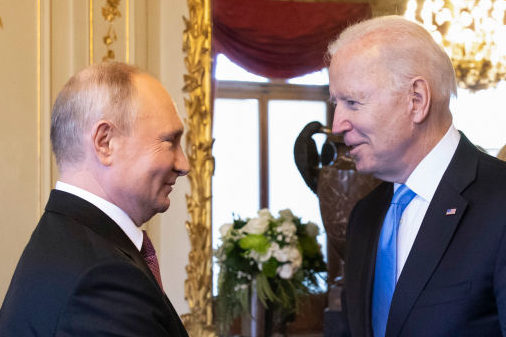After an embarrassing two-month start to its war in Ukraine marked by pictures of abandoned armored personnel carriers, destroyed tanks and stalled armored columns outside Ukraine’s major cities, the Russian army is re-tooling and re-arming itself for a more manageable fight in the east.
I use the word “manageable” not because the battle in the Donbas will be easy for Russian forces, but because the objective of expanding Russian control over the entirety of Donetsk and Luhansk is more realistic than overthrowing the Ukrainian government and occupying the entire country. Capturing, let alone holding, Kyiv, Kharkiv and Chernihiv would have entailed a massive number of personnel and a long-term commitment Russia doesn’t have the resources to sustain.
The Ukrainians have known for some time that Russia would be re-focusing its military campaign on the Donbas, an area roughly the size of New Hampshire, part of which has been outside Ukrainian government control for the last eight years. The Russian military has spent the past several days sending reinforcements and enablers to the front and conducting shaping operations against Ukrainian military checkpoints, weapons depots and air defense systems to soften the battlefield.
The Russian Defense Ministry claimed on April 19 that thousands of Ukrainian military targets were hit over a 24-hour period. Whether this is actually true (the Kremlin lies as often as humans breathe) is beside the point. The point is the Russian offensive in eastern Ukraine is now underway.
If you thought the last eight weeks in Ukraine were a bloody mess, the next weeks could be even worse. Many Ukrainian civilians have either chosen to stay in the Donbas or simply couldn’t evacuate in time, which means the same Russian airstrikes and artillery attacks that claimed thousands of lives in Ukraine’s north may claim thousands more in the east.
And the Russians don’t distinguish between military and civilian targets. If you have any doubts about that, just take a look at old photographs of Grozny in 2000 or Aleppo in 2016. Russian strikes turned both cities into barren wastelands of twisted rebar and cement. The fact that Aleksandr Dvornikov is now the commanding general of Russian operations in Ukraine bodes ill for the future. Dvornikov is the same man who commanded Russian forces in Syria, where indiscriminate bombing and starve-or-surrender sieges on the ground helped Syrian dictator Bashar al-Assad drive rebels out of their urban bastions.
Negotiations to end the war are on hold. Ukrainian President Volodymyr Zelensky and Russian President Vladimir Putin don’t agree on much, but both men have essentially thrown out any end-of-war settlement for the time being.
The Ukrainians don’t want to negotiate under duress, and coming to the table while their troops are being bombarded is the very essence of negotiating from a position of weakness. Putin, betting that Russian advances in the Donbas will provide him with more leverage at the negotiating table, doesn’t want to negotiate at the moment either. The combatants unfortunately believe they can extract more concessions by fighting rather than talking.
There was a time not so long ago when President Biden was hoping to establish a “stable, predictable relationship” with Russia, resisting Moscow when it undermined American interests but otherwise cooperating with the Russians on other issues (like arms control).
Needless to say, those hopes have been totally upended. Given Russia’s atrocities in Ukraine, Biden may never speak to Putin again. It’s becoming progressively more difficult to imagine a scenario in which Washington and Moscow work towards a semi-functional relationship, at least for as long as Putin rules the Kremlin. The American sanctions, Russian counter-sanctions and diplomatic expulsions have fueled a mutually reinforcing cycle of discontent, with hawks and hardliners on both sides writing and executing policy.
In the West at large, Russia is now depicted as a lost cause. “Meaningful dialogue, as we strived for before, is not an option for Russia,” NATO Secretary General Jens Stoltenberg said last month. Even French President Emmanuel Macron, who took it upon himself to act as the West’s emissary to Putin, is having second thoughts about maintaining an open line of communication with the Russian leader.
Being tough on principle is one thing. Being reckless is another. Right now, Washington’s policy on Russia is the former. The Biden administration has sent $2.6 billion on weapons for the Ukrainian army since the war began, contributing to the Russian military’s rout in Ukraine’s north. Those shipments will continue for as long as the war goes on.
The problem, however, is that the longer the war goes on and the more graphic the images on our TVs become, the more likely people in positions of responsibility will begin to advocate for reckless policies that could escalate the conflict. A no-fly zone, a safe zone in western Ukraine, and Senator Chris Coons’s call last week to consider deploying US troops to Ukraine are three examples of what those reckless policies would look like. The Biden administration has done an admirable job thus far of batting down these suggestions as unworkable, naïve and dangerous.
But don’t be fooled — it will take considerable discipline for the White House to navigate pressure to turn the United States into an active combatant. Here’s to hoping the administration acts with restraint.


















